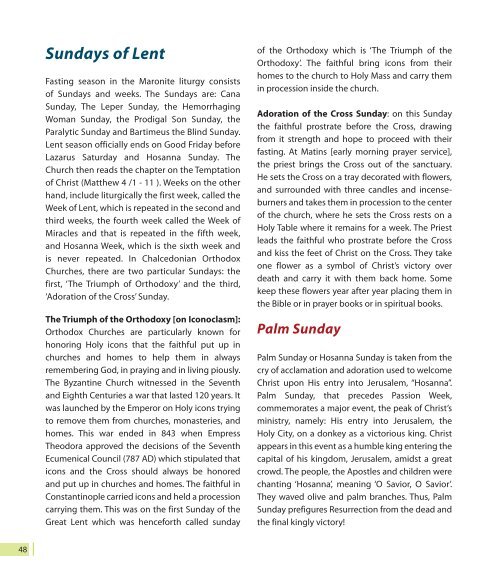Cultural aspects in Christian and Islamic religions - unesdoc - Unesco
Cultural aspects in Christian and Islamic religions - unesdoc - Unesco
Cultural aspects in Christian and Islamic religions - unesdoc - Unesco
Create successful ePaper yourself
Turn your PDF publications into a flip-book with our unique Google optimized e-Paper software.
48<br />
Sundays of Lent<br />
Fast<strong>in</strong>g season <strong>in</strong> the Maronite liturgy consists<br />
of Sundays <strong>and</strong> weeks. The Sundays are: Cana<br />
Sunday, The Leper Sunday, the Hemorrhag<strong>in</strong>g<br />
Woman Sunday, the Prodigal Son Sunday, the<br />
Paralytic Sunday <strong>and</strong> Bartimeus the Bl<strong>in</strong>d Sunday.<br />
Lent season officially ends on Good Friday before<br />
Lazarus Saturday <strong>and</strong> Hosanna Sunday. The<br />
Church then reads the chapter on the Temptation<br />
of Christ (Matthew 4 /1 - 11 ). Weeks on the other<br />
h<strong>and</strong>, <strong>in</strong>clude liturgically the first week, called the<br />
Week of Lent, which is repeated <strong>in</strong> the second <strong>and</strong><br />
third weeks, the fourth week called the Week of<br />
Miracles <strong>and</strong> that is repeated <strong>in</strong> the fifth week,<br />
<strong>and</strong> Hosanna Week, which is the sixth week <strong>and</strong><br />
is never repeated. In Chalcedonian Orthodox<br />
Churches, there are two particular Sundays: the<br />
first, ‘The Triumph of Orthodoxy’ <strong>and</strong> the third,<br />
‘Adoration of the Cross’ Sunday.<br />
The Triumph of the Orthodoxy [on Iconoclasm]:<br />
Orthodox Churches are particularly known for<br />
honor<strong>in</strong>g Holy icons that the faithful put up <strong>in</strong><br />
churches <strong>and</strong> homes to help them <strong>in</strong> always<br />
remember<strong>in</strong>g God, <strong>in</strong> pray<strong>in</strong>g <strong>and</strong> <strong>in</strong> liv<strong>in</strong>g piously.<br />
The Byzant<strong>in</strong>e Church witnessed <strong>in</strong> the Seventh<br />
<strong>and</strong> Eighth Centuries a war that lasted 120 years. It<br />
was launched by the Emperor on Holy icons try<strong>in</strong>g<br />
to remove them from churches, monasteries, <strong>and</strong><br />
homes. This war ended <strong>in</strong> 843 when Empress<br />
Theodora approved the decisions of the Seventh<br />
Ecumenical Council (787 AD) which stipulated that<br />
icons <strong>and</strong> the Cross should always be honored<br />
<strong>and</strong> put up <strong>in</strong> churches <strong>and</strong> homes. The faithful <strong>in</strong><br />
Constant<strong>in</strong>ople carried icons <strong>and</strong> held a procession<br />
carry<strong>in</strong>g them. This was on the first Sunday of the<br />
Great Lent which was henceforth called sunday<br />
of the Orthodoxy which is ‘The Triumph of the<br />
Orthodoxy’. The faithful br<strong>in</strong>g icons from their<br />
homes to the church to Holy Mass <strong>and</strong> carry them<br />
<strong>in</strong> procession <strong>in</strong>side the church.<br />
Adoration of the Cross Sunday: on this Sunday<br />
the faithful prostrate before the Cross, draw<strong>in</strong>g<br />
from it strength <strong>and</strong> hope to proceed with their<br />
fast<strong>in</strong>g. At Mat<strong>in</strong>s [early morn<strong>in</strong>g prayer service],<br />
the priest br<strong>in</strong>gs the Cross out of the sanctuary.<br />
He sets the Cross on a tray decorated with flowers,<br />
<strong>and</strong> surrounded with three c<strong>and</strong>les <strong>and</strong> <strong>in</strong>censeburners<br />
<strong>and</strong> takes them <strong>in</strong> procession to the center<br />
of the church, where he sets the Cross rests on a<br />
Holy Table where it rema<strong>in</strong>s for a week. The Priest<br />
leads the faithful who prostrate before the Cross<br />
<strong>and</strong> kiss the feet of Christ on the Cross. They take<br />
one flower as a symbol of Christ’s victory over<br />
death <strong>and</strong> carry it with them back home. Some<br />
keep these flowers year after year plac<strong>in</strong>g them <strong>in</strong><br />
the Bible or <strong>in</strong> prayer books or <strong>in</strong> spiritual books.<br />
Palm Sunday<br />
Palm Sunday or Hosanna Sunday is taken from the<br />
cry of acclamation <strong>and</strong> adoration used to welcome<br />
Christ upon His entry <strong>in</strong>to Jerusalem, “Hosanna”.<br />
Palm Sunday, that precedes Passion Week,<br />
commemorates a major event, the peak of Christ’s<br />
m<strong>in</strong>istry, namely: His entry <strong>in</strong>to Jerusalem, the<br />
Holy City, on a donkey as a victorious k<strong>in</strong>g. Christ<br />
appears <strong>in</strong> this event as a humble k<strong>in</strong>g enter<strong>in</strong>g the<br />
capital of his k<strong>in</strong>gdom, Jerusalem, amidst a great<br />
crowd. The people, the Apostles <strong>and</strong> children were<br />
chant<strong>in</strong>g ‘Hosanna’, mean<strong>in</strong>g ‘O Savior, O Savior’.<br />
They waved olive <strong>and</strong> palm branches. Thus, Palm<br />
Sunday prefigures Resurrection from the dead <strong>and</strong><br />
the f<strong>in</strong>al k<strong>in</strong>gly victory!

















